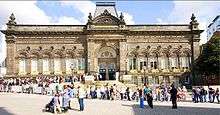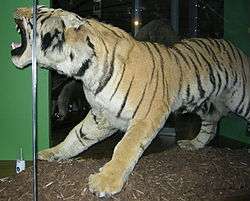Leeds City Museum
 Leeds City Museum | |
| Established | 1819; reopened 13 September 2008 |
|---|---|
| Location | Millennium Square, Leeds, West Yorkshire, England. |
| Coordinates | 53°48′06″N 1°32′50″W / 53.801617°N 1.547323°W |
| Type | Collection (museum), Heritage centre |
| Public transit access | Leeds railway station, Leeds City bus station |
| Website | Leeds City Museum |
Leeds City Museum, originally established in 1819, reopened on 13 September 2008 in Leeds, West Yorkshire, England. It is housed in the former Mechanics' Institute built by Cuthbert Brodrick, in Cookridge Street (now Millennium Square), which has been redeveloped to a design by Austin-Smith:Lord architects and Buro Happold engineers. Gallery and exhibit design is provided by Redman Design.
Admission to the museum is free of charge. Special exhibitions are hosted alongside a collection of displays from the Leeds Archive.
History
In 1819, a museum was established on Park Row by the Leeds Philosophical and Literary Society, and in 1821 it opened to the public. In 1921, control of the museum was handed to the Corporation of Leeds which later became Leeds City Council. In 1941, the museum building and artifacts were badly damaged by bombing. In 1965 the museum was closed, and a few exhibits removed to a couple of rooms in the city library in 1966. The oversized Leeds Tiger, the giant moose skeleton and the carved wooden cart took up much of the space. In 1999 the museum went into storage, though researchers and the public could view items by appointment. In 2000, the resource centre at Yeadon opened, under the same appointment-to-view arrangement. In 2001, Leeds City Council bid for National Lottery cash, and in 2004, it was awarded £19.5 million,[1] so in 2005, the Leeds Mechanics' Institute building began to be redesigned as Leeds City Museum, finally to reopen in 2008.[2]
The exhibits
While exhibits vary, they are mainly made up of exhibits from Leeds' history. The central hall has a large map of Leeds printed on the floor. There is also a scale model of the Quarry Hill flats. The exhibits are organised among several galleries. See a slideshow here.

Life on Earth gallery
This is the natural history gallery.
The Leeds Tiger
This exhibit - so beloved of the Leeds populace that when the curators wanted to throw it away, the Yorkshire Post newspaper held a campaign to retain it - has a strange history. It was a tigerskin rug when presented to the Museum in the 19th century. Museum records give the impression that the tiger had been shot for spending too much time near a village in India. The pelt was then combined with one or more other tigerskins, and instead of being mounted properly it was stuffed with straw. For over a century it has sagged somewhat, as can be seen in the photograph. Meanwhile, the story of a tiger shot for its mere presence at the edge of a village became a legend of the killer of one man, then of two people, then the serial killer of forty. However the pelt may now be dangerous after all, in a sense, as the Victorians may have preserved it with arsenical soap.[3] Museum staff have considered remounting it properly to improve its appearance, but it was felt that that would destroy its character and historical identity as a Victorian artefact and as the centrepiece of the museum in the eyes of the citizens.[4]

Ancient Worlds gallery
Here are archaeological items from home and abroad.
- Roman floor mosaic ca 250 CE. This was discovered at Aldborough (Yorkshire), known to the Romans as Isurium Brigantum.
- Hellenistic Greek tomb doors ca 250 BCE. These are carved in marble, in bas relief.
- The Leeds Mummy. In the 1941 bombing raids, two other mummies were destroyed, but Nesyamun's 3000-year-old mummy survived. It is displayed in the current museum building, alongside a rather striking reconstruction of his face.[5]
- Iron replica of Hellenistic Greek head of Aphrodite. This is a cast replica of the original 1st century BCE head in the British Museum. The original was discovered in 1872 at Satala (now Sadak) in north-eastern Turkey. The eyes were once inlaid with precious stones or paste. Apparently the top of the head was not designed to be empty, like a piece of modern art. It seems that the farmer found it when he hit the top of the head with his axe and damaged it.[6]
World View gallery
Various exhibitions showcase different cultures in turn.
Leeds Story gallery
The history of Leeds from prehistory to the modern day.
Collectors Corner and shop
Various collections appear here in rotation.
- The Circe bronze by Alfred Drury. This was commissioned from Drury in 1894 by Leeds Art Gallery. It was displaced to Park Square in the 1950s when Victorian art went out of fashion. It was weathered and damaged, but has been restored recently.[7] It was Drury who made the eight beautiful bronze lampholder girls in Leeds City Square, plus the bronze of Joseph Priestley nearby.[8][9]
Photographs of some of the exhibits

 Hellenistic Greek tomb door.
Hellenistic Greek tomb door.

References
- ↑ Heritage Lottery Fund: History in the Making, 22 September 2005
- ↑ Yorkshirepost.co.uk article: Long-awaited new museum set to go down in city's history Chris Bond, 12 September 2008.
- ↑ Chestofbooks.com webpage: Arsenical soap.
- ↑ Information received 10 March 2009 verbally from museum curator.
- ↑ 24dash.com: Sting in the tale of Leeds mummy, by Hannah Wooderson, 3 September 2008.
- ↑ Britishmuseum.org: Bronze head of a goddess, probably Aphrodite.
- ↑ Culture24: Leeds City Art Gallery Brings Victorian Statue In From The Cold 7 March 2008.
- ↑ A sculpture walk in Leeds.
- ↑ BBC.co.uk: Moving Statues
External links
| Wikimedia Commons has media related to Leeds City Museum. |